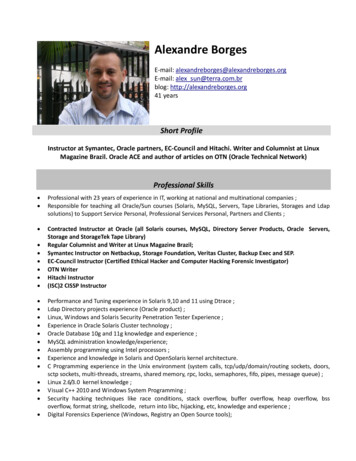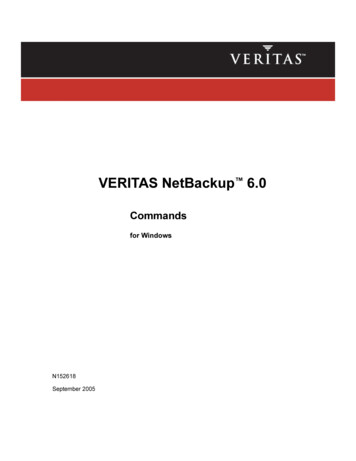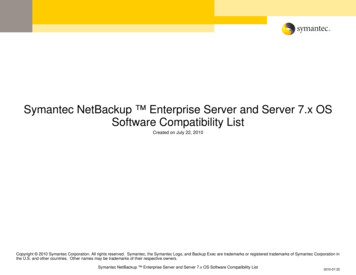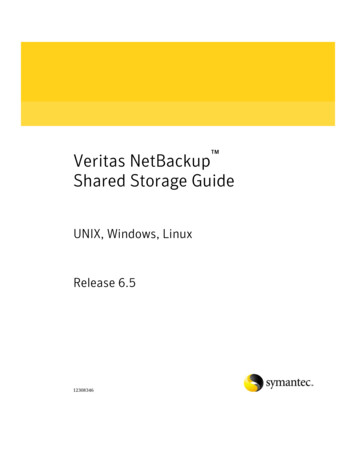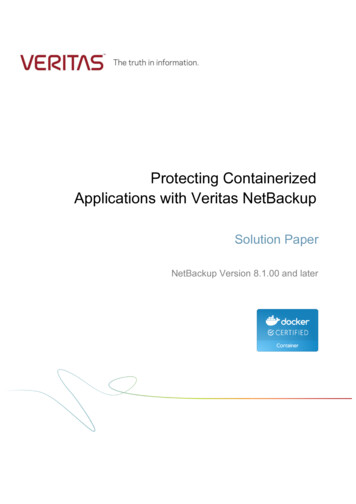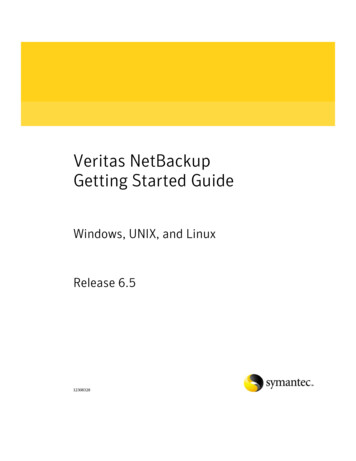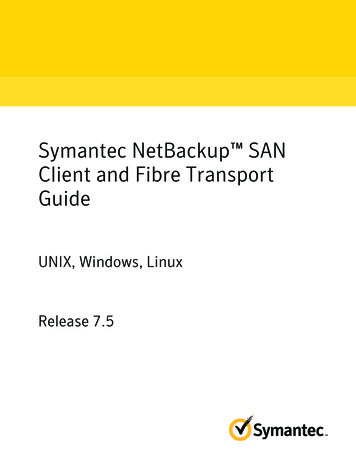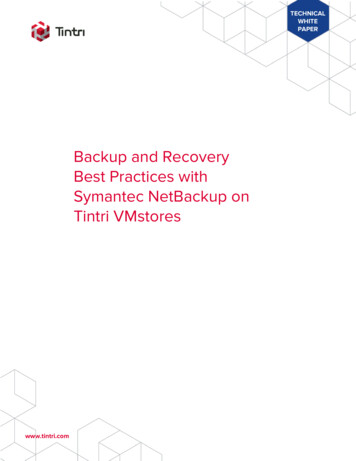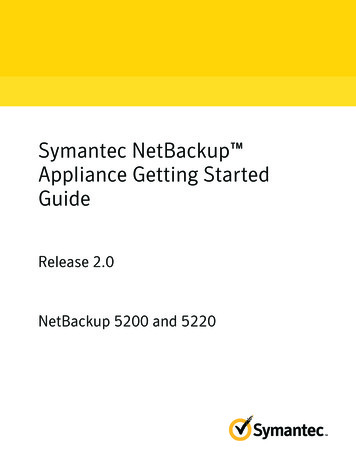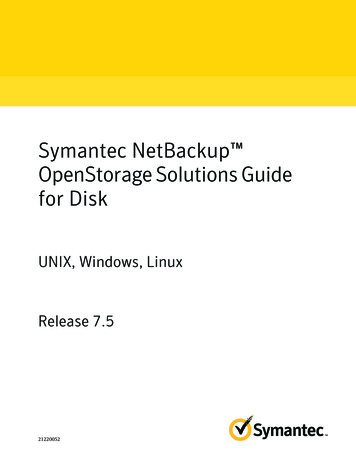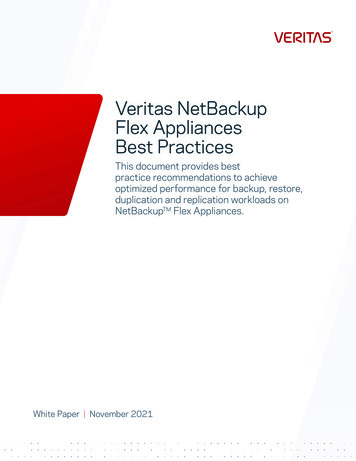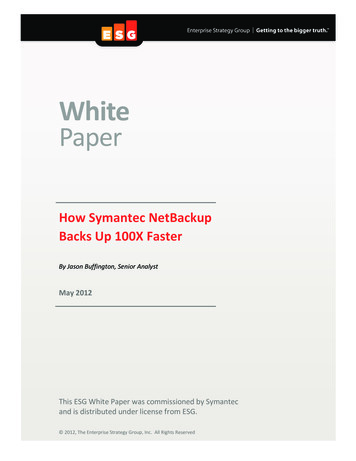
Transcription
WhitePaperHow Symantec NetBackupBacks Up 100X FasterBy Jason Buffington, Senior AnalystMay 2012This ESG White Paper was commissioned by Symantecand is distributed under license from ESG. 2012, The Enterprise Strategy Group, Inc. All Rights Reserved
White Paper: How Symantec NetBackup Backs Up 100X Faster2ContentsIntroduction . 3How to Improve Backup . 3NetBackup 7.5 – Theory of Operations . 3NetBackup 7.5 Client-Side Deduplication. 4NetBackup 7.5 Accelerator . 6The Perfect Solution? . 7ESG Testing . 7Two Considerations for Utilizing Accelerator and CSD. 8The Bigger Truth . 9All trademark names are property of their respective companies. Information contained in this publication has been obtained by sources TheEnterprise Strategy Group (ESG) considers to be reliable but is not warranted by ESG. This publication may contain opinions of ESG, which aresubject to change from time to time. This publication is copyrighted by The Enterprise Strategy Group, Inc. Any reproduction or redistribution ofthis publication, in whole or in part, whether in hard-copy format, electronically, or otherwise to persons not authorized to receive it, without theexpress consent of the Enterprise Strategy Group, Inc., is in violation of U.S. copyright law and will be subject to an action for civil damages and, ifapplicable, criminal prosecution. Should you have any questions, please contact ESG Client Relations at 508.482.0188. 2012, Enterprise Strategy Group, Inc. All Rights Reserved.
White Paper: How Symantec NetBackup Backs Up 100X Faster3IntroductionHow does performing backups 100X faster sound?Great? Of course.Achievable? Maybe.Symantec asked ESG to assess its claim that NetBackup 7.5 can perform backups up to 100X faster than traditionalbackups, as part of Symantec’s 2012 initiative to provide “Better Backup for All.” In this paper, we’ll look at thetrends in evolving one’s data protection techniques beyond traditional daily and weekly backups, dive deep into thetechnologies utilized by NetBackup 7.5, and assess its claims based on ESG testing and audits.How to Improve BackupTen years ago, the best thing that you could do to improve your data protection strategy was to embrace disk todisk to tape (D2D2T) strategies, such that your primary protection and recovery tier was faster performing fromdisk, compared to slower tape. With disk being a more ideal recovery format for single items and higher-performingfor recently protected data, D2D was a no-brainer. But disk-based protection, while improving RPO and RTO, wouldoften add at least 4X the production data set in additional backup storage. Incremental forever (and fewer fullbackups) helped, but still, disk storage would grow at least linearly to production data set size.Five years ago, the best thing to you could do was utilize deduplicated storage as the back-end repository for diskbased protection. Even without changing your backup software or methodology, disk-based protection becamemore economical by storing data more efficiently. Of course, one had to purchase deduplicating storage, which hada premium, but the cost savings almost always outweighed the initial investment. ESG research looked at dataprotection modernization trends in 2012 and found that most folks understood that the decision to utilizededuplication as part of disk-based backup was a “when” and not an “if”—with only 20% of respondents notplanning on leveraging deduplication.But there was room for improvement in that the backup software was often oblivious to the fact that the storagewas optimized and would send data that perhaps the storage already had. Backup software needed to get“smarter” about what was being sent. Symantec began optimizing those processes with NetBackup 7.0, andcontinues getting even smarter in NetBackup 7.5 by integrating deduplication and change tracking, all within theclient.NetBackup 7.5 – Theory of OperationsThe key to continuing to improve data protection is being smarter on what the production server is sending, period.NetBackup 7.5 delivers on that by using two separate, but better together, methodologies. Client-Side Deduplication (CSD) NetBackup 7.5 AcceleratorThe two technologies, CSD and Accelerator, are complementary, work together, and are in the same licensing/SKU,such that they can almost be thought of as a one-two punch. 2012, Enterprise Strategy Group, Inc. All Rights Reserved.
White Paper: How Symantec NetBackup Backs Up 100X Faster4NetBackup 7.5 Client-Side DeduplicationAs mentioned earlier, deduplication was originally delivered within storage appliances that would optimize how thebackup server stored its secondary copies. But this often was achieved without the backup server being aware ofthe optimization. In a “Good, Better, Best” taxonomy, that was “good” and, by most standards before it, “great” forearly disk-based protection solutions. A “better” approach involved the backup or media server being aware ofwhat was already stored within the deduplication appliance and only attempting to store new data blocks that theappliance did not already have. The “best” approach for most is Client-Side Deduplication (CSD), whereby not onlyis the backup/media server more intelligent, so is the backup agent on the production node—again, only sendingnew or unique fragments of data that the deduplicated storage does not have.Figure 1. Good, Better, Best Approaches for DeduplicationSource: Enterprise Strategy Group, 2012.Figure 1 shows the “Good, Better, Best” of 1TB of production data being protected through a media server and thento a deduplicated storage device. Good – using deduplicated storage as the target for disk-based protection, which should arguably be theminimum in today’s economy when using disk-based backup solutions. Better – the media server is deduplication aware/capable. Instead of sending everything to deduplicatedstorage that likely will discard most of it, the media server only sends new or unique fragments. Best – deduplication intelligence is at the production server, so only the data fragments that are not in thededuplicated storage pool are transmitted to the target disk, and the media server gets its catalog updates. 2012, Enterprise Strategy Group, Inc. All Rights Reserved.
White Paper: How Symantec NetBackup Backs Up 100X Faster5CSD in NetBackup does the “best” scenario, shown in Figure 1. The NetBackup client (agent) starts out behavingmuch like traditional backup agents, as it is installed and running as a service on the production machine. When abackup begins, the backup agent traverses the file system or workload data structure to identify data to be sent.But then, the magic happens.Figure 2. NetBackup 7.5 Client-Side DeduplicationSource: Symantec, 2012.As seen in Figure 2, the deduplication logic within a client-based agent parses out any redundant elements so thatonly unique blocks are sent from the production server to the NetBackup Media Server’s storage engine. To do thisrequires a few extra steps that are based on the NetBackup agent maintaining a database of the hashes of data thathave already been sent from that production server and are stored within the backup storage pool.1. When data is prepared for transmission, it is broken into chunks and each chunk is fingerprinted (hash keygenerated).2. The hashes are first compared against the local cache, which enables NetBackup to immediately discard filefragments that are already stored in the deduplicated storage pool.3. For fragments not in the cache, their hashes (not the data) are sent to the NetBackup Media Server in casethose fragments were written to the deduplicated storage from another NetBackup client agent. If so,those fragments are also discarded—yielding a truly global deduplicated pool in the NetBackup storage.4. Only those file fragments whose hashes were in neither the local agent’s cache nor already recorded in theMedia Server are transmitted from the production server to the Media Server.From there, the metadata about the changed files/objects is relayed “up” to the NetBackup Master Server’scatalog, as if the actual changed files were sent (and not just the unique blocks), while the unique fragments aresent “down” to the backup storage platform. 2012, Enterprise Strategy Group, Inc. All Rights Reserved.
White Paper: How Symantec NetBackup Backs Up 100X Faster6CSD already puts NetBackup in a class of high-performing backup solutions that smartly use deduplication, withouta dependency on deduplication-enabled hardware; with NetBackup 7.5, Symantec adds Accelerator to the mix.NetBackup 7.5 AcceleratorThe challenge that most client-side deduplication technologies face, including NetBackup, is the additional CPUimpact on the production server to deduplicate the data, along with the IO impact on the production disk as thebackup agent traverses the file system to determine what has changed. NetBackup Accelerator addresses thosechallenges.Shown in Figure 3, NetBackup Accelerator has a built-in, file-system-independent track log that intelligentlyidentifies changed files without traversing the entire file system. The track log comes into action only during thebackup, so other file system operations are not impacted as they would be with traditional file-system-specificchange journals. It can also work in conjunction with the file-system-specific change journal for Windows clients.Figure 3. NetBackup 7.5 AcceleratorSource: Symantec, 2012.Using this intelligent scanning (or by monitoring the file system if NTFS change journal is used), the AcceleratorAgent is able to identify the changed data without incurring the IO penalty that most backup agents cause. At thatpoint, the Accelerator agent can queue up only those changed segments from just those modified files to be sent tothe NetBackup Media Server’s storage engine. As part of the storage engine’s enhancements in NetBackup 7.5, thechanged segments from the files are received and an “Optimized Synthetic” full backup is extrapolated, based onthe changed data from Accelerator along with already stored elements within the backup storage pool. 2012, Enterprise Strategy Group, Inc. All Rights Reserved.
White Paper: How Symantec NetBackup Backs Up 100X Faster7The Perfect Solution?It is worth noting that the combination of Accelerator and CSD is not always viable. While the solution is ideal forunstructured (file) data and remote offices, Accelerator currently does not support transactional applications orhypervisor hosts whereas client-side deduplication does.In addition, Symantec has not changed the laws of physics or accelerated electrons such that data truly movesfaster; instead, it has looked at the kinds of data protection and movement being requested by customers anddelivered a smarter way to move far less data without sacrificing recoverability options after the fact.ESG TestingTo assess the net result of CSD and Accelerator in NetBackup 7.5, ESG visited the Symantec development facility inRoseville, Minnesota in March 2012 to better understand the technologies involved, conduct hands-on testing, andaudit previous test results that Symantec is using to claim “100X Faster Backups.”NetBackup Accelerator and CSD are both easily selectable options within the properties of backup policy. For initialhands-on testing, ESG used NetBackup 7.5 within the Attributes tab of the NetBackup policies dialog box (see Figure4).Figure 4. Enabling Accelerator and Client-Side Deduplication in NetBackup 7.5.Source: Enterprise Strategy Group, 2012.For initial baseline testing, ESG configured NetBackup to back up 500,000 randomly generated files totaling 50GB ofstorage. By forcing a full backup, the initial job transmitted data at 2.3MB/sec over simulated WAN to match thetests Symantec had earlier conducted from China to the United States. It completed in slightly over six hours(6:08:29).For the second test, after scripting minor data changes across the 500K files, ESG enabled NetBackup Acceleratorand CSD for another full backup. NetBackup 7.5 identified and transmitted 299MB out of the 50GB which hadchanged, with the job completing in 2 minutes and 34 seconds—with a stated optimization of 99.4% (or 147X fasterthan the without Acceleration or Client-Side Deduplication), as shown in Table 1. 2012, Enterprise Strategy Group, Inc. All Rights Reserved.
White Paper: How Symantec NetBackup Backs Up 100X Faster8Table 1. ESG Testing of NetBackup 7.5Without CSD or AcceleratorWith CSD and Accelerator6 hours, 8 minutes, 29 seconds50 GB2 minutes, 34 seconds299 MB99.4% OptimizationMultiple tests were conducted over the course of the ESG testing day (see Figure 5), all with similar results.Figure 5. NetBackup 7.5 Activity Log from ESG on-site testingSource: Enterprise Strategy Group, 2012To compress time, scripting was used to dynamically and randomly change blocks within files in a manner similar toad hoc home directory modifications. While the files remained fixed at just over 500K, the data changesconsistently yielded optimized full backups within 1:20 and 8:50 minutes, compared with a traditional full backuptaking just over 6 hours.It should be noted that the 100X claim, while both impressive and defensible, is based on performing a full backupfrom a production server perspective while actually sending far less than an incremental backup’s data stream.With that in mind, why would one ever perform incremental backups? After all, they (and differentials) wereoriginally created because, while it would seem ideal to always perform full backups for the fastest restores,bandwidth and backup windows were always a challenge. But is it that simple?Two Considerations for Utilizing Accelerator and CSDThe benefits of full backups from a restore perspective are based on the assumption that restores take longer byfirst restoring the latest full backup, followed by layering each incremental or differential to the restored data setuntil the selected point in time is achieved. NetBackup, like most disk-based backup solutions, stores its data withinthe storage pool as randomly-accessible disk blocks, so the access time of any block is relatively equal. However, akey differentiation in NetBackup is its optimized synthetic full operation, which is routinely done by the MediaServer so that it creates indexes of blocks that will constitute a single-pass restore. By doing so, NetBackup gainsthe capability to do a “full restore” (single pass) without taking the performance penalty of continually doing “fullbackups.”The other key difference between a full and an incremental backup is cataloging. A full backup (whether the data istransmitted or not) updates the NetBackup Master Server with the metadata attributes of every file that was in thedata set, whereas an incremental backup only sends the metadata of those files that were changed during that day.So, for the benefit of NetBackup catalog size, incremental backups are still warranted (and still benefit from theclient-side optimizations discussed earlier). 2012, Enterprise Strategy Group, Inc. All Rights Reserved.
White Paper: How Symantec NetBackup Backs Up 100X Faster9The Bigger Truth100X faster? Arguably so (in some cases).Appreciably faster? YES, and impressively so.Even in a worst case, contrived niche architecture, if NetBackup achieved 10X or even just 5X optimization, whowouldn’t want their nightly backup to complete in one hour instead of five?Of course, your mileage will vary based on sizes of files and data change rates, but what NetBackup 7.5 shows isthat the evolution of data protection is continuing: Disk-based is better than tape-based for most data protection scenarios (with cloud-based solutions gainingviability). Deduplicated disk is more cost effective and viable, and arguably a requirement for disk-based backup. The smartest way to optimize the experience is to put as much of the logic and discernment at the client.Symantec hasn’t changed the nature of data movement, but it has changed the volume of data that needs to bemoved and time it takes to move it. Facilitating its dedupe technology and the visibility that Accelerator has withinthe production file system and data stream, Symantec has integrated several innovative techniques into NetBackup,its longstanding enterprise-worthy solution, and offer a capability that should cause customers to ask “can mybackup agents do that?” 2012, Enterprise Strategy Group, Inc. All Rights Reserved.
20 Asylum Street Milford, MA 01757 Tel: 508.482.0188 Fax: 508.482.0218 www.enterprisestrategygroup.com
a dependency on deduplication-enabled hardware; with NetBackup 7.5, Symantec adds Accelerator to the mix. NetBackup 7.5 Accelerator The challenge that most client-side deduplication technologies face, in
